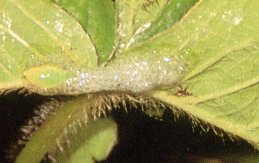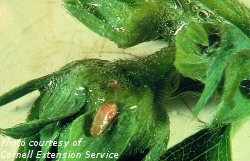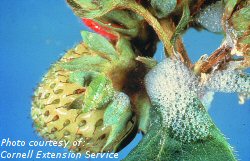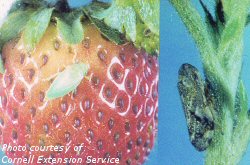Spittlebugs


Spittlebug nymph on strawberry bud

Spittle mass on strawberry

Spittle adults: newly emerged left, older adult on right
Host Plants And Distribution
Spittlebugs are found throughout North America and are pests of strawberry plantings in areas of high relative humidity, such as the Pacific Northwest. They are seldom a problem in the Canadian Prairies. Spittlebugs feed on a variety of hosts, including strawberry, clovers, grasses, weeds and some ornamentals. Populations are higher in weedy fields and proper weed control can keep numbers down.
Biology
Adult spittlebugs are 5-7 mm in length and are dull brown in colour. Nymphs vary from white to pale green in colour and have dark eyes and distinct legs. These insects overwinter as eggs on the lower leaves and stems of host plants and in the stubble of strawberry plantings. Egg hatch coincides with appearance of blossoms. Nymphs feed within a frothy mass of spittle (hence the common name), piercing plant tissue and sucking plant juices. The nymphs are often found on and between clusters of flower buds and within the crown. Nymphs mature in late June and emerge from the spittle as winged adults. There is one generation per year.
Spittlebugs are easily recognized by the mass of foam that they secrete around their bodies. One species that occurs on strawberries is the meadow spittlebug. The nymphs are white to green in colour, with dark eyes and distinct legs. The adult meadow spittlebug is bright green when it emerges but quickly turns a dull brown. It is about 5-7 mm long.
Symptoms Of Damage
In the Canadian Prairies, spittlebugs seldom cause economic damage. Most often, they are a nuisance as pickers dislike the appearance of the spittle. During wet summers or in fields under heavy irrigation, numbers of spittlebugs may be high enough to weaken plants and distort leaves and berries.
In strawberries, the nymphs can be found on and between clusters of flower buds, on leaf stems, and on young growth within the crown. The nymphs are quite small at early-bloom but are easily seen by their froth during the picking season. The nymphs usually mature in June and emerge from the spittle masses as winged grey-brown adults. When present in large numbers, the nymphs can weaken plants and distort the leaves and berries, especially during dry summers. However, they are mainly a nuisance pest because strawberry pickers dislike getting their hands smeared with the spittle while gathering the berries.
Scouting Techniques
Fields are easily monitored for the froth or spittle created by the nymphs while feeding. During hot, dry weather, nymphs will be lower on the plant, making them more difficult to locate.
Monitoring
Check the fields biweekly. Look for the froth or white spittle produced by nymphs. The froth is usually 1-2 cm in diameter. More than one nymph may be hidden in the froth. During hot, dry weather, the froth masses are usually lower on the plant, making it more difficult to find the nymphs. During warm, humid weather, the opposite is true. Adult spittlebugs are present throughout the summer. They can be collected by gently using a sweep net to brush the upper foliage.
Economic Thresholds
As spittlebugs seldom cause economic damage, there is no established economic threshold. A threshold based on aesthetic appearance of the plants to pickers is one froth mass per square foot. Growers should strongly consider the impact of insecticides on predators and parasites before controlling what is not an economic problem.
Comments
Because these insects are usually more abundant in weedy strawberry fields, good weed control practices may prevent serious infestations.

